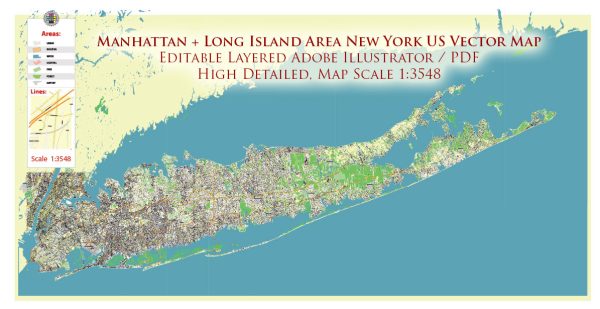The transportation system in the Manhattan and Long Island area in the United States is extensive and includes a variety of modes of transportation to help people get around the region. Here are some key components of the transportation system in this area:
- Subway: Manhattan has one of the most iconic subway systems in the world, operated by the Metropolitan Transportation Authority (MTA). The subway connects Manhattan with other boroughs, including Brooklyn and Queens. Long Island is also served by the Long Island Rail Road (LIRR), a commuter rail system that connects the island with Manhattan.
- Buses: Both Manhattan and Long Island have extensive bus networks that provide local and regional transportation. The MTA operates the buses in Manhattan, while Nassau Inter-County Express (NICE) and Suffolk County Transit operate the buses in various parts of Long Island.
- Bridges and Tunnels: To travel between Manhattan and Long Island by road, there are several bridges and tunnels, including the Brooklyn-Battery Tunnel, Queens-Midtown Tunnel, and various bridges like the Queensboro Bridge.
- Ferries: There are also ferry services connecting Manhattan and Long Island. The Staten Island Ferry provides service to Staten Island from Manhattan, and there are several other ferry services that connect parts of Long Island to Manhattan.
- Airports: Both Manhattan and Long Island are served by major airports. Manhattan is served primarily by John F. Kennedy International Airport (JFK) and LaGuardia Airport (LGA), while Long Island is served by Long Island MacArthur Airport (ISP) and some smaller regional airports.
- Roadways: Various major highways and roadways connect Manhattan and Long Island. For example, the Long Island Expressway (I-495) is a major artery connecting the two areas.
- Biking: There are increasing efforts to make Manhattan and Long Island more bike-friendly, with bike lanes and bike-sharing programs in place.
- Walking: Manhattan is known for being a very walkable city, and there are extensive sidewalks and pedestrian areas. Long Island, depending on the specific location, may also have walkable areas, particularly in more urbanized parts.
- Rideshare Services: Services like Uber and Lyft are widely available in Manhattan and Long Island, offering convenient transportation options.
- Rail Systems: In addition to the LIRR, there are other regional rail systems like the Metro-North Railroad, which connects Manhattan to parts of upstate New York and Connecticut.
The transportation system in this region is well-connected and provides various options for commuting and traveling between Manhattan and Long Island, as well as within the respective areas. It’s important to note that the transportation network is subject to changes, expansions, and improvements, so it’s a good idea to check with local transportation authorities for the most up-to-date information and routes.


 Author: Kirill Shrayber, Ph.D.
Author: Kirill Shrayber, Ph.D.